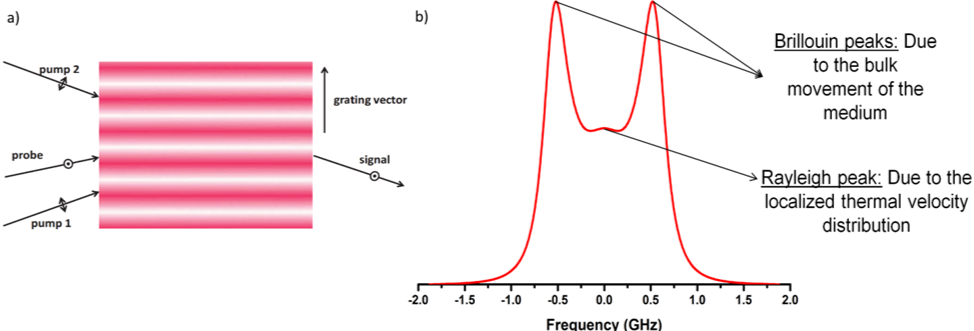Coherent Rayleigh-Brillouin Scattering
Advanced Diagnostics Navigation
- Atomic and molecular species, positive and negative ions
- Laser-Induced Fluorescence (LIF) and Two-Photon Absorption LIF (TALIF)
- Radar Resonant Enhanced Multi-Photon Ionization (Radar REMPI)
- Characterization of plasma, chemical composition and dynamic behavior
- Electron velocity distribution function, gas flow velocity and temperature
- Electric field and space potential
- Nanoparticle Diagnostics
- Surface Diagnostics
Coherent Rayleigh-Brillouin Scattering (CRBS)
Point measurements for measuring polarizability, temperature, and mass of small particles and atoms
Suited for particles 0.1 < dp < 100 nm
Sensitivity threshold is particle density 109 – 1011 cm-3

CRBS relies on the creation of periodic refractive index (i.e. density) gratings within a medium. These periodic refractive index (and density) modulations are created by the interference of two laser beams, called the pumps, within the medium. The frequency difference of the two pump beams is linearly changed such that it creates interference patterns of different velocity (top figure on left). Due to the ponderomotive force, particles of the medium will concentrate in the high intensity regions of this interference pattern, thus giving rise to a so-called optical lattice. A third beam, called the probe, is incident upon this lattice at an angle fulfilling the Bragg relation and is coherently scattered from it. The result of this process is a fourth beam, called the signal. By measuring the intensity of the signal beam with respect to the velocity of the optical lattice we obtain the Rayleigh-Brillouin spectrum (top figure on right). A CRBS spectrum consists of a spectroscopic triplet: the Rayleigh peak, centered at zero velocity/frequency difference and Doppler broadened due to the thermal motion of particles, and the two Brillouin peaks, equidistant to the Rayleigh peak and symmetrical to it, due to the collective movement of the particles, centered at the speed of sound of the medium.
In PPPL, we have designed and developed a laser system, which has already demonstrated its capability of obtaining a single shot CRBS spectrum in a gas or gas mixture, and have shown how this can be used for remote gas pressure and polarizability measurements. More importantly, we have used the same laser system in order to probe volumetric nanoparticle formation in a graphitic arc discharge, where we have been successful in determining in situ the presence and mass of nanoparticles in the arc discharge environment. The lowest sensitivity threshold for CRBS diagnostics is particle density of 109-1011 cm-3.

 This capability is located at the Princeton Plasma Physics Laboratory.
This capability is located at the Princeton Plasma Physics Laboratory.
